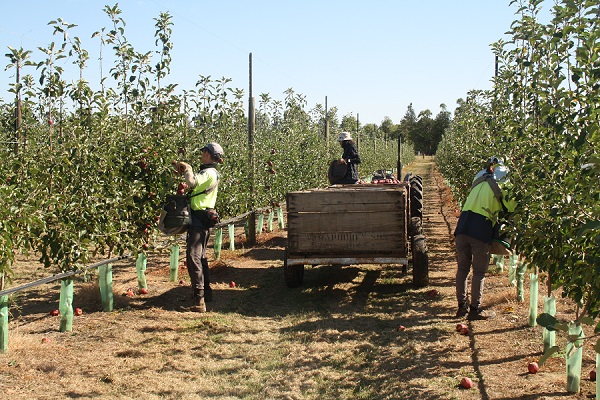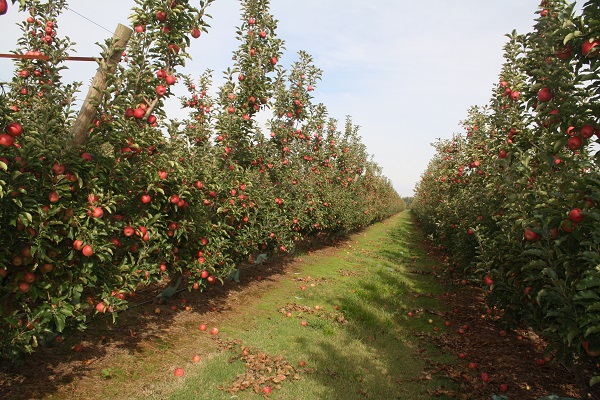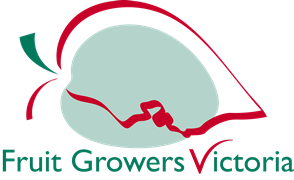Strains of M.9 have earned a reputation as outstanding rootstocks for vigorous non-spur varieties.
It is therefore not surprising, that the fruit industries and nurseries around the world promote and encourage fruit growers to plant apple trees on M.9 at higher tree densities than before. But is this always a good move? And have all climates and soils always suited apple trees on M.9?
A rootstock must be carefully selected to match the orchard system, the vigour of the variety, the growth potential of the climate and the soil. There is no one best dwarfing rootstock for all climates and soils.
While many possible rootstocks are available in Australia, only a few (including M.9) are common in nurseries. However, in the USA there are at least 25 different rootstocks suitable for apple.
M.9 has a small root system but this is affected to some extent by the scion. It is possible that the small root system itself contributes to the dwarfing of the scions, because shoot and branch length are closely related to root length.
Growers choose rootstocks not only for the tree size and efficiency. Many of the dwarfing-type rootstocks popular in Europe are not adapted to the shallow topsoils, hot summers and high light intensities in apple-growing areas such as north-central Victoria and Western Australia.
An awareness of the shortcomings of M.9 can improve orchard performance when matching rootstock to prevailing climates and soils in parts of mainland Australia.
Apple orchards on M.9 in warmer areas than in Europe, have sometimes failed to reach expected yields. Trees on the more vigorous rootstock MM.106 often produced well above that of trees on M.9.
It is well known that M.9 is sensitive to high soil temperatures, i.e. above 20°C, possibly because roots, especially feeding roots, do not grow new roots. In countries with long hot summers, tree vigour can be quite low in many apple orchards on M.9. Roots grow best in the range of 20°C to 25°C. Above 25˚C root growth slows down, and above 35°C no new roots are formed. This means that with very hot summers root growth of trees on M.9 is limited, especially in the upper depths of soil where most of the feeder roots grow.
Soil temperatures of 37°C and 33°C have been recorded in an Ardmona (Victoria) apple orchard at 60 mm and 120 mm depths respectively, when the ambient temperature was 40° C, and 5 hours after the microjet irrigation was turned off. At a more common ambient temperature of 33° C, the soil temperatures at 60 mm and 120 mm depths were 32° C and 29° C respectively.
Studies have shown, that the distribution of assimilate between roots, frame and fruit is ultimately controlled by the growth of the roots.
Roots have a capacity to store not only carbohydrates and nutrients, roots are also sites for the synthesis of growth substances such as cytokinins and gibberellins. These growth substances produced in the roots are transported to the top of the tree and exert hormonal control over shoot growth. When growth of the root system slows down or ceases altogether at high soil temperatures, the production of cytokinins in new roots may also slow down or cease, limiting top growth. Thus, reduced root growth brings about a compensatory reduced shoot growth. There is no doubt that roots, acting through a hormonal function play a major role in the maintenance and balance of the growth of the whole tree.
High root zone temperatures also reduce tree growth of stone fruit in inland parts of Australia, where summer soil temperatures, particularly during the day, can be quite warm.
In an Ardmona orchard in north-central Victoria, active shoot growth of young Modi trees on M.9 occurred in October and November and had virtually stopped in December. Average day temperature in December was 27.4° C, with 9 days above 30° C, and 35.7° C the highest day temperature. Based on tree size (trunk cross-sectional area), it has been estimated that full canopy of the trees, planted 4x1 m, will take 7 or 8 years. The benchmark for full canopy (and full crop) for trees on M.9 is 5 years.
Growth of apple trees on M.9 in some orchards in mainland Australia has been stunted rather than dwarfed, canopy development has been relatively slow and fruit on these trees has been subject to severe sunburn. Certain soil types will not sustain the vigour needed for the selected tree density combinations.
In Australia, a range of vigour will be needed for the different apple growing regions with different climates and soils, as M.9 vigour may be too weak for some soils.
A good understanding of the interactions between rootstocks and scions, and climate and soil, would help growers select better rootstocks in the future.
In some countries, such as Chile, there has been a significant trend towards high-density planting on M.9 rootstocks in newer blocks, but semi-dwarfing rootstocks such as MM.106 and M.7 are planted on new adjacent blocks.
In South Africa growers are worried that their trees on dwarfing rootstocks will runt out in their relatively harsh summers, poor quality soils and restricted water supply. They are also worried that tree behaviour differ between apples on dwarfing rootstocks such as M.9, and their commonly used semi-dwarfing MM.106 rootstock. So there is a general lack of confidence about embracing dwarf rootstocks for their intensive plantings.
Resistance to pests and diseases, such as woolly apple aphid and phytophthora, must be considered.
M.9 is not resistant to woolly apple aphid. Woolly apple aphid is much more of a serious pest in Australia than in the northern hemisphere due to the milder climate. The attack of woolly apple aphid on trees on M.9 is accentuated because the tree is already less vigorous. Damaged root systems of young trees severely decrease the uptake of water and nutrients by the trees. Older and more vigorous trees are less affected, but contaminated fruit and unpleasant conditions for pickers and pruners are a problem.
With the introduction and use of effective pesticides against woolly apple aphid in the past, fruit growers have been game enough to use non-resistant rootstocks, such as M.9. Withdrawal of, or restrictions on recent pesticides, may lead this pest to become economically significant once again.
With the slow resistance developing to certain chemicals and limited availability of appropriate chemicals, biological control is needed for woolly apple aphid.
Excessive crop loads readily stall the growth of young trees on M.9. Many growers overcrop their young trees at the expense of tree growth, because they are anxious to get their orchard into production and have fruit to sell.
Generally, dwarfing rootstocks, such as M.9, tend to ripen fruit earlier than more vigorous rootstocks. Although in some years the differences can be great, they cannot be predicted. Harvest maturity of trees on MM.106 may be delayed for up to 6 days more than trees on M.9. Crop load has a huge effect on time of maturity, and in particular the rate that fruit colour develops. Early heavy thinning to optimal crop loads will advance harvest, particularly if blossoms are thinned.
Young apple orchards on M.9 need good nutrition for strong spring growth, and good bud break, and cannot stand much competition for water and nutrients. On light or sandy soils, trees on M.9 need mulching.
For best results, apple trees on M.9 require a deep, fertile, and a well-drained soil, and the best orchard management.
Where unfavourable climates and soils prevent tree growth extending further into the season, and maximise the performance of high density apple orchards on M.9, growers may have to:
- Ridge the shallow top soil.
- Install drip irrigation (preferably subsurface and pulsating).
- Fertigate frequently.
- Use a surface mulch.
- Cover the trees with net and/or install overhead cooling.
- Plant well-feathered trees close enough so they can quickly fill their allotted spaces and reach their maximum permissible height.
What is the alternative if these measures cannot be implemented or are not cost-effective?
With woolly apple aphid continuing to be a major apple pest and with only limiting control by chemicals, predators and parasites, resistant rootstocks with a range of dwarfing and semi-dwarfing growth habits, will provide a long-term solution.
One immediate solution is to stick with MM.106 because:
- Trees on this rootstock are very precocious, and as a result of heavy crops can develop into smaller trees.
- MM.106 has performed very well in harsh climates for more than 60 years.
- MM.106 is the best known semi-dwarfing rootstock for apple trees in Australia, the USA, Canada, South Africa, South America and New Zealand due to early and high production, good tree growth, and good root anchorage.
- Trees on MM.106 grow shoots for longer than M.9 do. The initial vigour of MM.106, which also extends further into the season than trees on M.9, quickly fills the trees’ spaces. Once cropped, trees grow more slowly and remain highly productive.
- MM.106 has excellent nursery characteristics. It grafts easily with high success. M.9 tends to be rather temperamental, and, unless the grafting is well done, up to 30 per cent can fail.
- MM.106 is resistant to woolly apple aphid.
- MM.106 is highly susceptible to Phytophthora. However, it has also been found in other rootstocks including M.9 if the soil gets wet enough. Good drainage is essential and rows should be ridged. Pre- and post-harvest foliar sprays of phosphorus acid products (e.g. Agri-fos) will reduce the risk of infection.
- MM.106 tends to have a more dwarfing effect on Granny Smith trees than other varieties.
For orchards in climates and soils less suited to the dwarfing M.9 rootstock, the more vigorous MM.106 rootstock remains one of the growers’ best options.
If you are worried about having to cope with excess vigour - remember, excess vigour is a much easier problem to fix than is managing weak growth, because you can use numerous tools, such as the growth regulators Prohexadione-calcium (sold as Regalis® or Apogee®) and Paclobutrazol (sold as Payback®), which keep trees calm, improve skin blush, and reduce the cost of summer pruning.

Figure 1. These Modi trees on M.9 (2500 trees /ha), are trained on an upright trellis, are growing in a shallow topsoil in north-central Victoria and have experienced three hot summers since planting. Although the trees are well managed, canopy development and initial yield in year 3 (7 t/ha) lagged well behind yield benchmarks for the appropriate tree density and rootstock. It will probably take at least 7 years for canopies to develop completely and for trees to reach full production, compared with up to 5 years for trees on M.9 in deep topsoils and cool climates.

Figure 2. These Pink Lady trees on MM.106, trained on Open Tatura, and have been growing over 4 hot summers since planting in the same locality and soil type as those in Figure 1. Accumulated yield of 2 harvests from these 4-year-old trees (64 t/ha) exceeded the production benchmark for any other rootstock (60t/ha), and at a lower tree density (2222 trees/ha) than trees in Figure 1 (2500 trees/ha).
Bas van den Ende is a consultant in fruit production (ret.). Dr Judy Tisdall is a soil scientist, editor of Soil Research & Tillage, and Honorary senior lecturer in Soil Science at La Trobe University, Melbourne.


